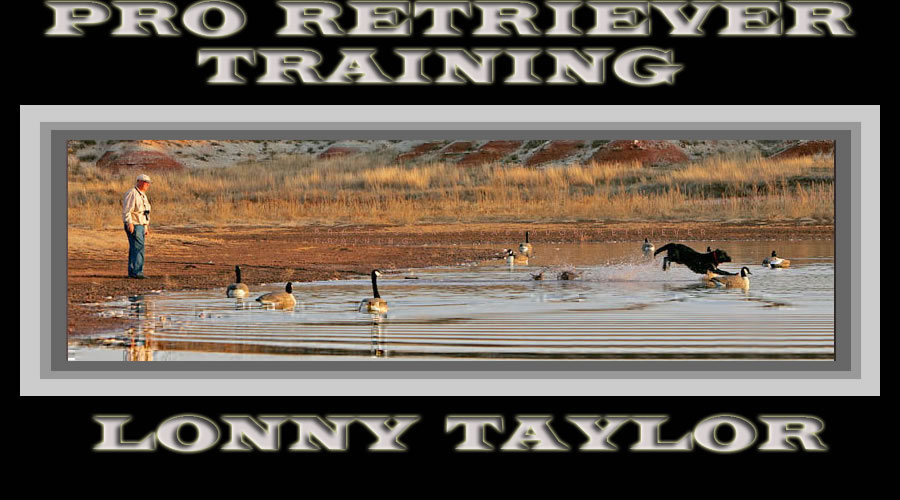Home
Labrador Retriever Training Lonny's Achievements Taylor Made Programs Lonny's Training Philosophy Started Gun Dogs Puppies For Sale Contact Us Articles A Finished Gun Dog Dog Training Definitions Hunt Test Information Choosing A Puppy Labrador Retriever Training Tips The Value Of A Trained Retriever Pro-Retriever Trainer Slide Show |
CHOOSING A RETRIEVER PUPPY—WHY GOOD BLOODLINES MATTERDave Alvarez has owned dozens of gun dogs over his 50 years of waterfowl and upland bird hunting, and he is known for brokering trained gun dogs to clients who are looking for a top-flight hunting companion. “I’d much rather spend $1,000 on a well-bred puppy than $200,” says Dave. “It costs the same to feed, vet, and train a good puppy as it does a bad one. The price of the puppy is just the beginning.” There are three important criteria for choosing a good puppy: conformation, bloodlines, and temperament. “First and foremost is conformation,” says Dave Alvarez. “Mike Gould wrote as good a chapter about Labrador conformation as anyone has ever discussed in ‘The Labrador Shooting Dog.’” In “The Labrador Shooting Dog”, Gould discusses such factors as the ideal shape of a dog’s foot, the length of a dog’s back, the shape of the dog’s croup, the set of the dog’s tail, and even the color of a dog’s eyes. Assuming that the puppy buyer is looking for a hunting dog, Gould’s parameters are very exacting. Good conformation starts with both parents having an OFA hip x-ray to detect dysplasia. Hip and elbow dysplasia is a debilitating disease that will cripple a dog as it ages, making it impossible for a dysplastic dog to perform in the field. A litter should not be bred from parents who do not grade out at least “good” or “excellent” on their OFA certifications. (Only ¼ of 1% of dogs grade out to “excellent”.) The same goes for eyes. CERF tests look for retinal dysplasia, progressive retinal atrophy, and genetic cataracts. Aside from the basics of good OFA and CERF results, pro retriever trainer Lonny Taylor of Taylor Made Retrievers is looking for athletic, fit dogs with handsome heads, lean builds, keen eyes, strong retrieving desire, “bird drive”, and a willingness to please. A fit female should weigh between 55 and 65 pounds, and a fit male should weigh between 60 and 75 pounds. The great majority of these dogs come from field trial bloodlines, says Lonny. “Close to 90% of the dogs I train and title come from good field trial bloodlines,” Lonny says. “Every now and then I get a dog with no particular breeding who does well, but that’s not very common.” Show dog bloodlines, says Lonny, typically feature dogs who are too short-legged, barrel-chested, and wide to perform well in the field. “Most show dogs just don’t have good endurance. They’re not built for long days in the field,” Lonny says. “And you can forget about those 130-pound Labradors,” Lonny says. “That’s ridiculous. Think about it—who’s going to make the best Army Ranger—a guy who’s 5’11” and 175 pounds, or a guy who’s 6’6” and 330?” So how can you tell what is a show champion and what is a field champion? If you look at a dog’s pedigree, “Ch” means show champion. “FC” means field champion, “AFC” means amateur field champion, and the big daddy of ‘em all is “NFC”, which denotes the one dog that is that year’s national field champion. “NAFC” means national amateur field champion, and CFC means Canadian national field champion and CNAFC means Canadian National Amateur Field Champion. On the hunt test side of things (see article LINK), JH means Junior Hunter, SH means Senior Hunter, and MH means Master Hunter. “A general rule of thumb is that if the dog’s parents don’t show a field championship or Master Hunter title one generation back, I wouldn’t breed the litter,” says Dave Alvarez. “A well-bred litter should have 20 or 30 field championships, master hunter titles, or senior hunter titles in a four-generation pedigree with 30 ancestors. Those are the puppies that are worth $1,000 to $2,500.” “Pick up a copy of Field Trial News sometime and see who’s winning,” says Lonny Taylor. “The results are posted every month, and you’ll see some dogs again and again. That means those dogs are performing at a high level. You should look for those bloodlines in a puppy’s pedigree.” Temperament is just as important as anything, says Lonny. “If I’ve got a nice dog with a good disposition who really likes to retrieve and listens well, my job is a lot easier than if I’m training a dog who is hard-headed but athletic and talented.” How can you tell these things about an 8-week-old puppy? Look at the parents. Is the female a good mother? Despite her recent pregnancy, is she in good shape? Is the male a proven hunter, strong retriever, and a good citizen? “I like the puppies who pay attention to me,” says Lonny. “That doesn’t mean they should be cowering around my feet, but if I move, I want them to watch where I’m going,” Lonny says. “Puppies that are too timid are often tough to train. They want to quit on you,” Lonny believes. “The ultimate goal, of course, is a finished gun dog,” Lonny says. (LINK to Finished Gun Dog article.) “It’s a long road from an eight-week-old puppy to a finished gun dog, and perhaps a Master Hunter title or Field Championship. It can take over three years. Let’s start with the best puppies that we can find!” Choosing a Labrador retriever puppy, yellow and black Labrador retriever puppies for sale, AKC and HCR hunt test training, hunt test results, Labrador retriever training tips, gun dog training programs, professional Labrador retriever dog trainer |
EditRegion2 |
